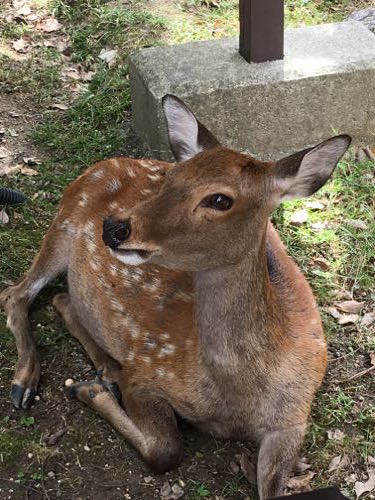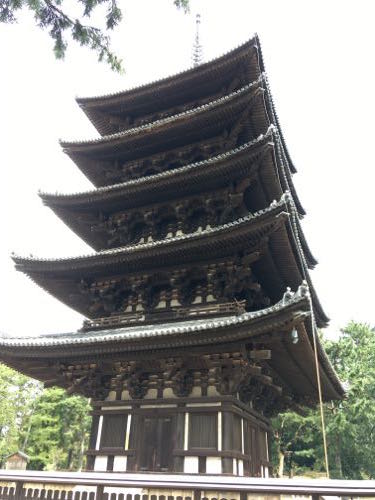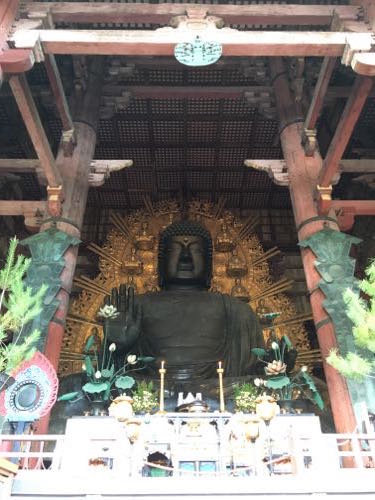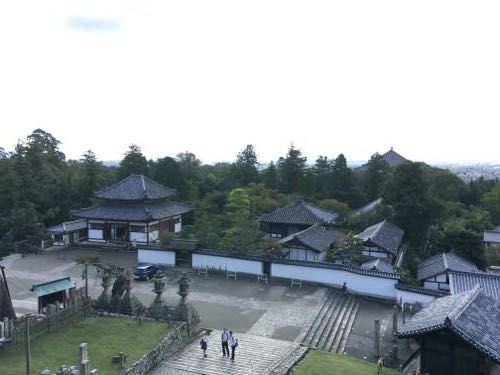I have visited Nara Park, and Nara was filled with history (and deer!). There are Todaiji-temple, Kofukuji Temple and Kasuga Taisha (Kasuga Grand Shrine) close by, they were all amazing! If you love the both history and deer, I am sure you’d love Nara Park. Here’s what you should know before visiting Nara Park, I hope you enjoy staying in Nara.
Basic Information
Nara Park, where? – Nara Park is located in Nara Prefecture, bordering Kyoto and Osaka Prefecture, Kansai Region.
From Kansai airport to Nara station, it takes around 1.5 – 2 hours by bus or train, and from Kyoto station it takes around 45 minutes by JR rapid train. (There’s Kintetsu train too) From Nara station, you can walk to Nara Park. (It takes about 30 minutes or so.)
Population? – Nara prefecture has the population of 1.33 million as of May 2019 and its number is decreasing for 19 consecutive years since 2000, according to the official website of Nara prefecture.
What is it famous for? – If you asked Japanese people about Nara prefecture, many of them would tell you, “Nara has Daibutsu (giant Buddha) and deer”; Nara is especially famous for these two things. “Daibutsu” refers to the giant Buddha in Todaiji temple, which was founded in 8th century (Nara period), in the purpose of stabilizing the society with the power of Buddhism.
The “deer” refers to the deer at the Nara Park; they are wild deer living there. However you might wonder, “Why so many deer living there?” the answer would be that the part of Nara Park is also the precincts of Kasuga Taisha (Kasuga Grand Shrine) and there the deer have always been protected as they are said to be sacred, the messenger of the gods.
About Deer – Deer at Nara Park are wild, so please respect them and if you want to feed them, there are “deer crackers” (Shika-senbei in Japanese) sold at the Nara Park and they were made from wheat flour and rice bran, perfectly safe for the deer to eat.

History? – Nara was the capital of Japan, basically in 7th – 8th century until 784. (after that the capital was moved to Kyoto.)
Especially Nara is known for the “Heijo-kyo” (a capital of Japan in 710-740 and again in 745-785), and its “Tempyo bunka” (Tenpyo Culture), which is the Buddhist culture flourished with the influences of the countries across the ocean, such as the Tang dynasty. For the perfect example of Tempyo Bunka, there is “Hokkedo (also known as Sangatsudo)” at Todaiji temple, which is the oldest buidling of the temple, built in Nara period (8th century) with the 10 Buddhist statues within; you can have a look and feel the ancient history of Nara.
Temperature? – According to the Meteorological Agency, the average annual temperature of Nara is 14.9℃, the lowest average temperature of 3.9℃ in January and with the highest average of 26.9℃ in August. The rainiest season is June (in general, the period from June to the beginning of July is called “Tsuyu” in Japan, which basically means the “rainy season”).
By the way .. Kyoto and Nara has the height restriction to preserve the view of old traditional city, thus there are no tall buildings like Tokyo or Osaka. Also there are colour restrictions for the signs, and thus you can see many signs in Kyoto or Nara using dark colours such as black, white and brown. (For example at some places in Kyoto, the famous McDonald’s red colour is replaced with dark brown).
How it looks like
I went to Nara in the autumn, October, and it was beautiful. The weather was nice and warm.

Why Pagoda’s still standing? – As walking through the park, a five-storied pagoda at Kofukuji-temple came into my sight. It was firstly built in 730, but burnt down by the fire for five times and reconstructed in 1426, Muromachi period.
But wait, Japan has many earthquakes, right? As a child I was really curious why these pagodas were still standing today after many big earthquakes. I was astonished when I knew the answer for it; the wooden pagodas (or some temples) are adopting base-isolated structure/seismic isolation system, which is the traditional ancient constructing technique of Japan. Well, obviously I am not an expert in this area but I’d write what I have learnt from the experts..
Pagoda’s Amazing Structure – Think about the soup bowl facing down, and put four more bowls on top of another. The five soup bowls are piled up, and consider this as a five-storied pagoda. When earthquake hit the bowls, it all collapses easily. But if you make a hole at the bottom of each bowls and put a stick into the each hole and pile them up again, imagine what would happen? This time, when the earthquake hit, the bowls would sway but wouldn’t collapse, as there is a stick at the center and it keeps five bowls together!
The “Tokyo Skytree” opened in 2012 is using the similar constructing technique, learnt from these wooden pagodas.
It is amazing to know how smart they were in the past, and look what they have done.. they are all stunning. I really hope you enjoy watching the wooden pagodas in Japan.
Coming back to the pagoda at Kofukuji temple, it is the second highest wooden pagodas in Japan with the height of 50.1 metres, and it is designated as a national treasure. (The highest one is at Toji temple, in Kyoto)

Daibutsu is amazing, but don’t forget “Great South Gate (Nandai-mon)” (completed in 1203) at Todaiji-temple. It was amazing too, was definitely worth spending my time and money! Also at the gate, two statues of “Kongo Rikishi” and they are both stunning too.

Nara is one of the most historical city of Japan, I hope you enjoy staying here.
Thank you for reading, ありがとうございました!(Arigatou)
